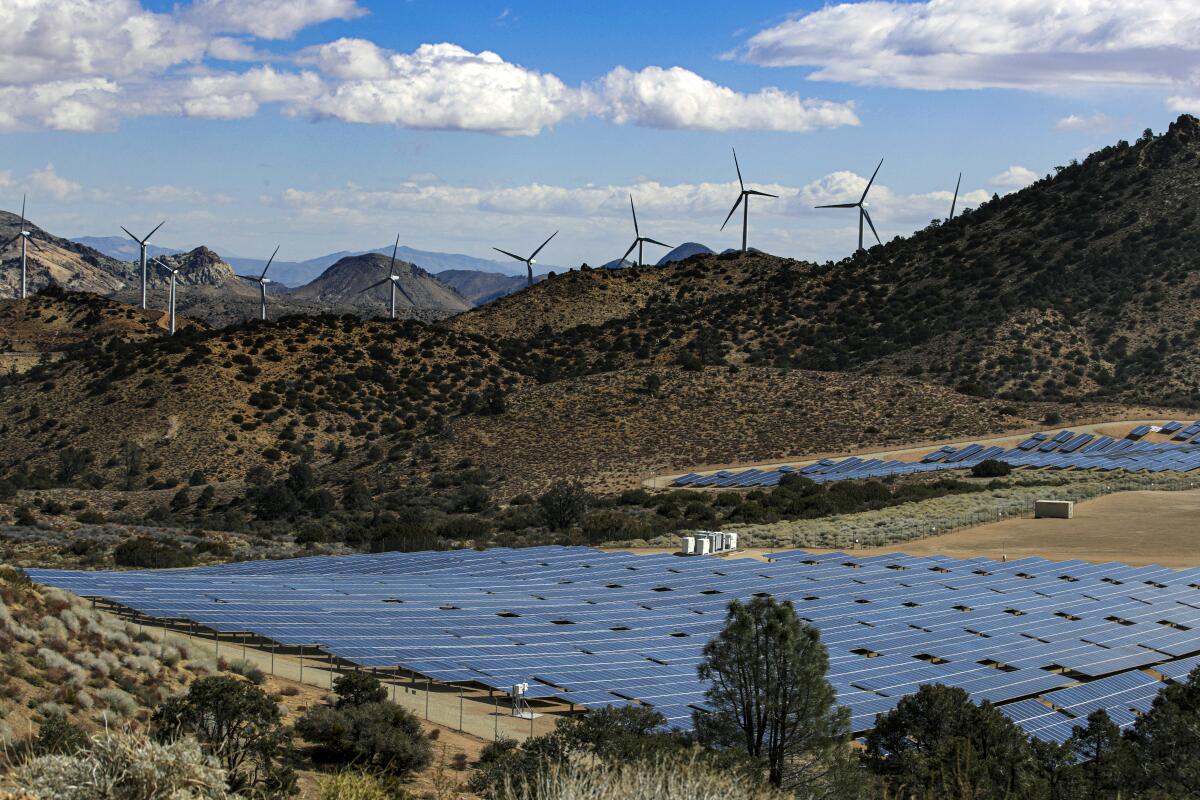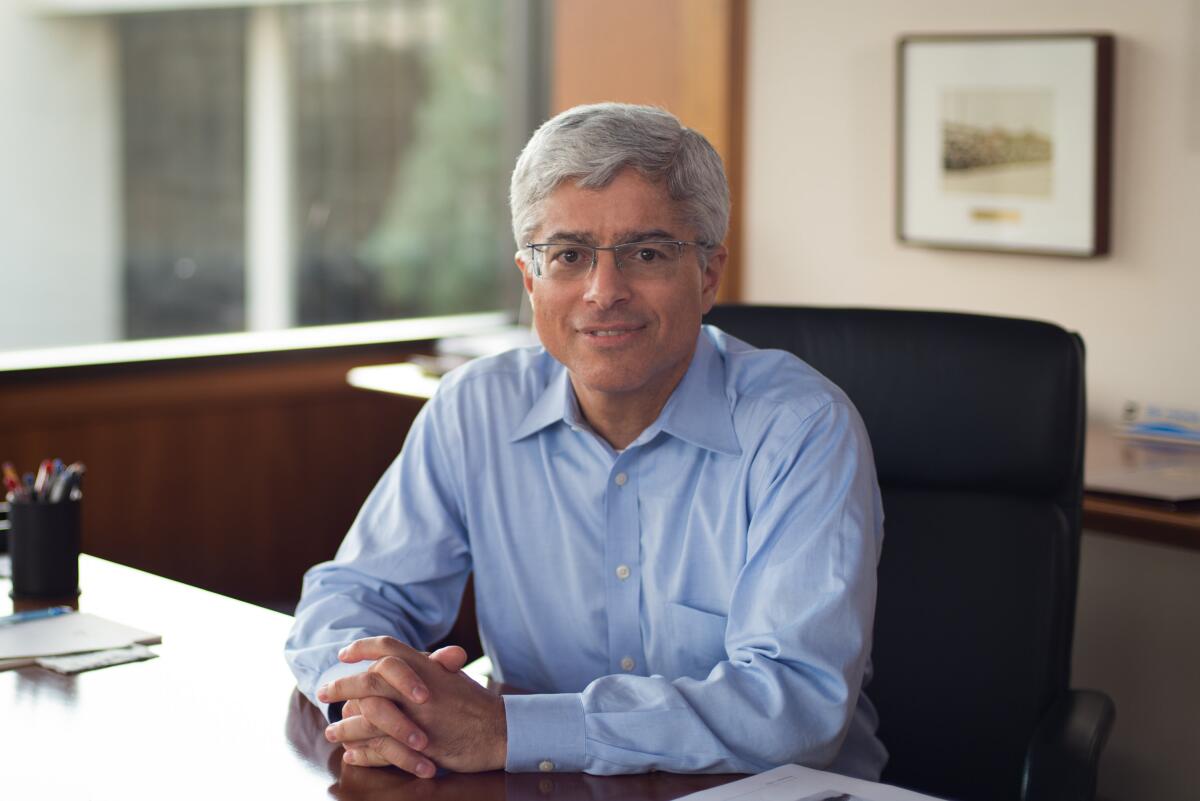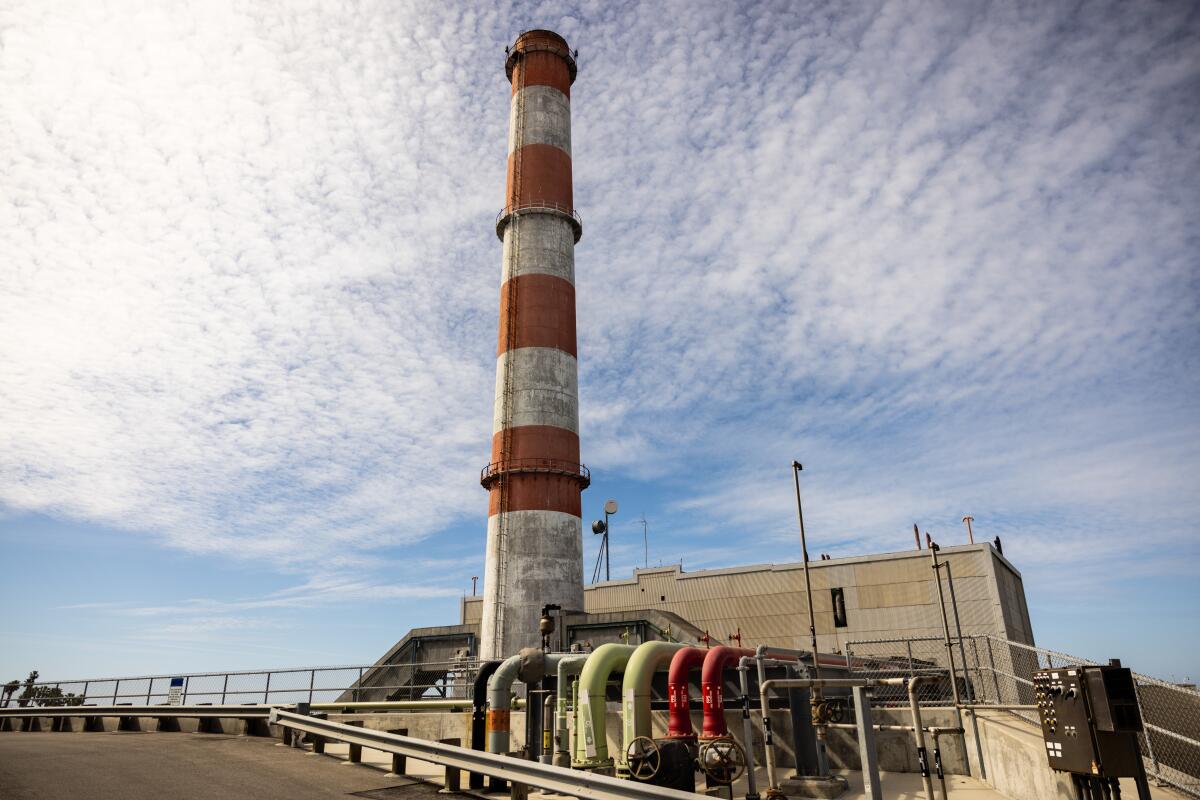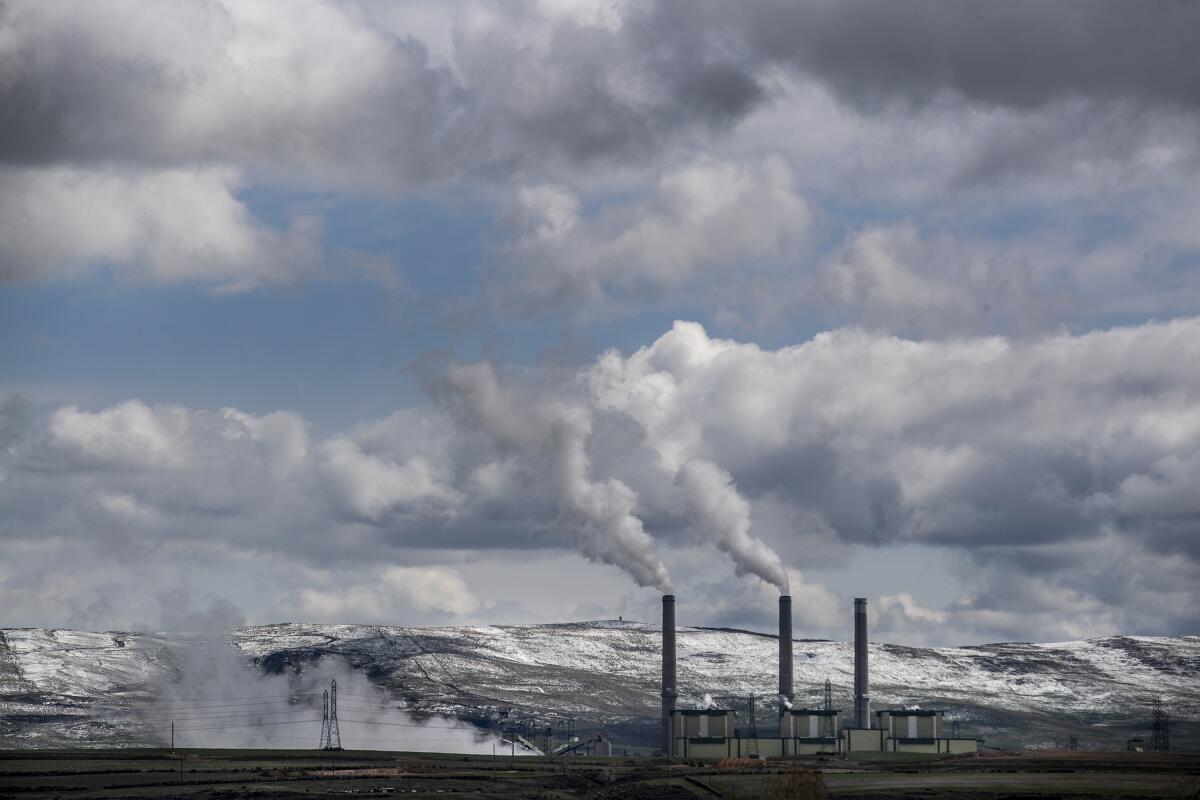Utilities say they want clean energy. So why are they opposing Biden’s plan?

- Share via
This story was originally published in Boiling Point, a newsletter about climate change and the environment. Sign up here to get it in your inbox.
Southern California Edison has worked hard to burnish its image as a clean energy champion.
The Rosemead-based electric utility — which serves 15 million people and, full disclosure, buys ad space in this newsletter — got 45% of its power from climate-friendly sources last year and has called for an 80% clean grid statewide by 2030. And although the company waged a successful campaign to slash rooftop solar incentives, it’s a leading advocate for electric cars and electric heat pumps and stoves in homes, which can reduce planet-warming pollution while also boosting utility-industry profits.
So why is Edison’s longtime leader sounding the alarm about President Biden’s latest climate plan?
In addition to serving as president and chief executive of Edison’s parent company, Pedro Pizarro was recently chosen as board chair of the Edison Electric Institute, a trade group for electric utilities across the country. In that role, Pizarro is pushing for big changes to Biden’s sweeping proposal to limit greenhouse gas emissions from coal- and gas-fired power plants — a stance that has led some climate advocates to accuse him of a dangerous hypocrisy.
“While Southern California Edison boasts that it is ‘leading the transformation of the electric power industry,’ it’s really leading the electricity industry backward to dirty fossil fuels,” UC Santa Barbara political scientist Leah Stokes wrote in a Times opinion piece.
Some environmental groups have lobbed similar accusations at the utility industry as a whole, urging executives to reject the Edison Electric Institute’s stance. At least one major utility — although not an institute member — did exactly that this week, with Constellation Energy Corp.’s top executive, Joe Dominguez, saying in a written statement that he was “disappointed to see many of my peers represented by the Edison Electric Institute and others working to block these very practical measures.”
So what do Pizarro and many of his fellow utility executives object to?
I got him on the phone this week to find out. Our full conversation is below.

But first, some context.
The rule proposed in May by Biden’s Environmental Protection Agency would place limits on planet-warming pollution from fossil fueled power plants. Coal plants that companies want to keep running past 2039 would need to be outfitted with systems capable of capturing 90% of their carbon emissions. Coal plants with earlier shutdown dates would face less rigorous limits.
Operators of large gas plants — facilities bigger than 300 megawatts that operate at least 50% of the time — would have two choices. They could either capture 90% of their carbon emissions by 2035 or switch to a fuel blend of at least 30% hydrogen by 2032 (and 96% hydrogen by 2038). That hydrogen would almost certainly need to be produced via renewable energy.
Federal officials have pitched those requirements as crucial to cutting U.S. climate pollution in half by 2030, as Biden pledged on the international stage, and also to fulfilling the president’s campaign-trail promise of a 100% clean electric grid by 2035.
But for some climate activists, the proposed rule is too weak. A stronger rule, they believe, would force more plants to capture their emissions, or else prompt utility companies to replace those plants with renewable energy and battery storage.
Jay Duffy, litigation director at the Clean Air Task Force, called Biden’s proposal “a step in the right direction.”
“We can achieve even greater emissions reductions at an even lower cost,” Duffy said in a written statement.
The Edison Electric Institute — whose member companies serve nearly 250 million people — took a different position.
In a letter submitted to the Environmental Protection Agency just ahead of Tuesday’s public comment deadline, the group argued that carbon capture and clean hydrogen technologies aren’t yet cheap enough or reliable enough to be counted on. The timeline laid out by the Biden administration, the group suggested, could cause energy bills paid by homes and businesses to rise, or force utilities to shut down coal and gas plants that can’t comply — potentially resulting in power shortages and blackouts.
Better to extend the compliance deadlines and create more flexibility for power companies, the trade group argued.
As for Stokes’ opinion piece, Pizarro’s company issued a written statement calling it “short on facts and misleading.” The utility pointed to the industry’s track record on climate — U.S. power plant emissions have fallen 36% since 2005 — and noted that the Edison Electric Institute defended the federal government’s authority to regulate those emissions at the Supreme Court.
“While some people are writing about climate change, the electric industry continues to do something about it,” the utility wrote.

This might have been less complicated if not for the Supreme Court. In a 6-3 ruling last year, the court’s conservative majority ruled that the Clean Air Act doesn’t give the federal government authority to require a broad shift from fossil fuels to renewable energy across the power sector, as President Obama had tried to do through a regulation known as the Clean Power Plan.
As a result, Biden’s only option is to require steps that limit emissions from individual power plants — known as inside-the-fenceline measures. That’s why his appointees proposed a rule that requires capturing carbon or switching to green hydrogen.
Are those technologies really not yet feasible? And if so, what should utility companies be doing instead?
I posed those questions to Pizarro. The following transcript of our conversation has been edited and condensed for clarity.
**
Let’s start simple: Does the Edison Electric Institute support or oppose Biden’s carbon rule as currently written?
We support the Environmental Protection Agency having a rule. We support some of the elements, and we think some of the elements need change.
And by the way, there’s no daylight between Southern California Edison and the Edison Electric Institute on this particular topic. The institute has a diverse membership. Sometimes there’s daylight on any given position with any given member. On this one, I have my Edison hat and my EEI hat on at the same time, because they have the same view.
And I think this is a place where all members agree — EEI is very focused on supporting the energy transition to be as clean as we can, as fast as we can, while safeguarding reliability and affordability.
Which parts of the regulation do you support, and which parts do you oppose?
The proposed rule creates these subcategories with different timelines for coal plants, where the level of emissions reduction required increases with the amount of time until retirement. If you’re going to retire in two years, not very much is required. If you’re going to retire in 10 years, there are all sorts of requirements. EEI in general is supportive of that kind of approach.
I wish there had been an approach like that for gas plants. Because we still need gas, including in California. When you look at Southern California Edison’s “Pathway 2045” analysis, it shows that in 2045, when the state gets to net-zero emissions, 6% of the electricity still comes from natural gas. The California Air Resources Board projects 13% gas.
In other parts of the country, it’s likely you’ll see some new gas plants built as part of the energy transition. You need the flexibility of firing those plants up and down to support greater renewable resources, particularly solar and wind farms.

And that continued need for gas helps explain why you don’t support parts of this rule, right?
The way the rule is constructed, it assumes that clean hydrogen and carbon capture are adequately proven such that they are now compliance requirements for gas plants. We’d need to have these compliance technologies by the early 2030s.
And that’s a concern, because we don’t think the technology is there yet. And the microsecond after the rule gets adopted, there will be at least a dozen red-state attorneys general who are going to file suits to get this thing thrown out.
We don’t want that. We want a rule that actually withstands legal tests and the test of time, because otherwise the utility industry as a whole just lives with uncertainty. And that’s not a good thing. We want certainty so people can finance investment.
This is the same thing that happened with President Obama’s Clean Power Plan. It got thrown out by the courts. But by the way — even though it got thrown out, our industry cut emissions by more than the plan would have required, sooner than it would have required. So that shows the commitment we’ve had to getting as clean as we can.
Is carbon capture really not ready for prime time yet?
The Environmental Protection Agency claims the technology has been adequately demonstrated. Legally, you need to show that it’s mature enough to be available economically and at scale. It’s kind of like saying, “Hey, we know that seat belts work. You can get enough seat belts for every car you manufacture. So therefore we can require that every car have them.”
Carbon capture is not there. The EPA is looking at a standard of reducing emissions 90% by 2035. It points to two carbon-capture demonstrations, one of which is a project in Canada that has mostly operated at a 70% to 75% reduction and more recently was at less than 40%. The second project is Petra Nova in Texas, which shut down because of economic problems. And those were both carbon capture from coal plants. Gas plants are harder, because the concentration of carbon dioxide coming out is lower.
You also need a transport system to take the captured carbon and move it to storage. That would presumably be a whole system of pipelines, whether it’s existing pipelines that get reconfigured or new pipelines that get built. You know how hard it is to permit and build energy infrastructure. So the idea that we’ll have thousands of miles of pipelines 10 years from now, when it takes us 11 years to get a transmission line built because of all the permitting issues — that’s really challenging to believe.
I assume you’ve got similar concerns with renewable hydrogen technology.
Exactly. It still needs a lot of research and development and demonstration.
I’m a scientist by training. I believe in technology. I know we can get there, especially with funding from the Inflation Reduction Act. At Southern California Edison, we are basically depending on there being carbon capture and hydrogen by 2045.
But I don’t think we can get there by 2030.

In your view, is President Biden’s goal of 100% clean electricity by 2035 not feasible?
We’ve been open with the administration about this. I even had the opportunity personally to sit down with the president early last year, with several of my EEI colleagues. Having a hard target of zero emissions in the electric sector by 2035 — I just don’t see how we get there, given the state of the technology, the amount of the deployment of renewable energy that would be needed, and then the need to make sure it’s done reliably and affordably.
And by the way, that last carbon molecule in the electric sector is going to be really expensive to take out. We’re much better off spending that dollar elsewhere, such as electric vehicles or electric buildings, because we’re going to get much more bang for the buck. We’re going to eliminate many more carbon molecules.
Part of the criticism of Edison Electric Institute from the environmental community is that utility companies have been big supporters of federal funding and tax credits for carbon capture and hydrogen — and now you’re asking the feds not to require those technologies, at least not so fast. What would you prefer to see from the Biden administration here? A longer timeline, or no requirements whatsoever?
I think the industry recognizes the need to set requirements. We support the need and ability for the Environmental Protection Agency to regulate our sector and our power plants. It needs to be a pragmatic and realistic regulation.
So yes, I think timeline would be one of the things to look at here, and the how much by when.
One other example — that 50% capacity factor limitation in the proposed rule, where only large gas plants that operate at least 50% of the time need to reduce their emissions? We think that will actually increase emissions in the near- to midterm. The more efficient gas plants are typically the larger ones. And if you can’t afford carbon capture or hydrogen because the technology’s not ready yet, you’re going to have a bunch of those most efficient plants limiting themselves to 50% capacity factor. And then power will have to come from someplace else. You’re going to see the less efficient, more highly emitting plants run more.
Then should we require all gas plants to reduce their climate pollution, not just the biggest ones?
It really depends on what timeline you’re talking about. If you said, “Let’s make it apply to everybody and still keep the 2030-ish timeline,” then let’s get ready for a lot more rolling blackouts across the country.

I think some of the skepticism of the electric industry’s arguments stems from a lack of trust. Outside California, many utilities want to build more gas plants, or keep their coal plants running as long as possible — positions that often aren’t compatible with avoiding the worst consequences of the climate crisis.
What would you say to people who simply don’t trust your industry as an honest broker on climate?
I would just say, go look at the numbers. Go look at the fact that the industry has exceeded President Obama’s Clean Power Plan targets well ahead of that timeline. Over the last decade, 60% of all new generation has been wind and solar. And since 2020, 78% of new generation has been wind and solar. That’s not Edison. That’s all of my peers across the country.
At the same time, we’ve got to acknowledge this is not just about the utilities. It’s also about their regulators, and the states they’re in. The reality is, if you look state by state, you have a broad diversity of views about the pace of the energy transition. These utilities serve their customers, and they have to get approval from their local regulators.
All of that notwithstanding, my colleagues at the Edison Electric Institute elected a Californian as board chair. There is unanimous commitment to getting as clean as we can as fast as we can, while keeping the lights on at a reasonable price for our customers.
Do you want to respond specifically to Leah Stokes’ opinion piece, calling you hypocritical?
Obviously I disagree. It is unfortunate. I’m fine with having debates over ideas as long as they’re grounded in facts. It is sad when the discourse becomes more personal, which I thought that was. But so be it. We will continue to take the high road.
I’m proud to be representing our industry. It’s a really wonderful industry that truly collaborates and helps each other out. I’m proud of our team that went to Puerto Rico after Hurricane Maria. I got to visit them. That was engineered by the Edison Electric Institute, as were the hundreds of folks from multiple states that were there. Those are the folks I’m representing.
ONE MORE THING

One more thing about the Edison Electric Institute.
I wrote two years ago about the Center for Biological Diversity urging federal officials to make it harder for utility companies to charge customers for trade association dues — including Edison Electric Institute memberships. Although companies are already barred from charging homes and businesses for EEI’s political lobbying — utility shareholders must pay those costs — critics say it’s too easy for utilities to fudge the numbers and charge customers for advocacy activities that aren’t technically lobbying.
The Center for Biological Diversity petitioned the Federal Energy Regulatory Commission in March 2021, asking the agency to require utilities to list all trade association dues on the side of the ledger paid for by shareholders. That way, the group argued, the burden would be on the companies to prove to regulators which of those costs should instead be borne by ratepayers.
Twenty-nine months later, the commission still hasn’t made a decision.
“We’re just patiently waiting at this stage,” Center for Biological Diversity attorney Howard Crystal told me.
In the interim, several states have taken action. Legislators in Colorado, Connecticut and Maine passed laws this year prohibiting utilities from charging customers for trade association dues. In Congress, meanwhile, Rep. Kathy Castor (D-Fla.) introduced a bill last month that would put a similar prohibition on utility companies nationwide.
I asked Pizarro about the Center for Biological Diversity’s petition. He emphasized that the Edison Electric Institute does much more than advocacy, bringing together member companies to support one another with emergency response after hurricanes and wildfires, and to coordinate on other initiatives that benefit families and businesses, such as cybersecurity.
“EEI dues are helping to pay for that operational work that’s keeping our customers safer,” Pizarro said.
We’ll be back in your inbox Tuesday. To view this newsletter in your Web browser, click here. And for more climate and environment news, follow @Sammy_Roth on Twitter.
Toward a more sustainable California
Get Boiling Point, our newsletter exploring climate change, energy and the environment, and become part of the conversation — and the solution.
You may occasionally receive promotional content from the Los Angeles Times.






